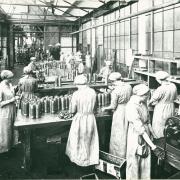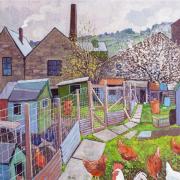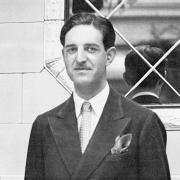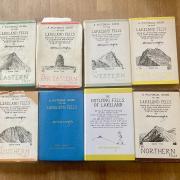Britain has never produced another hero like Dan Dare. Charlie Connelly pays tribute to a figure with strong Lancashire roots who has shaped our art, literature, science and architecture.

Born in 1967, Dan Dare turned 50, retired as a pilot and disappeared from the pages of the Eagle comic in the same year. And if that’s not mind-bending enough, according to a headstone in Highgate Cemetery once visited by his arch-nemesis, the Mekon, Dare was killed in action in 1950, despite his interplanetary adventures taking place during a futuristic 1990s.
These days the ‘pilot of the future’ lurches confusingly around the past, but the influence of Dan Dare’s eponymous comic strip can still be seen in the work of artists, writers, architects and scientists all inspired by the wholesome, shiny-faced British space pilot with the lantern jaw and pipe clenched between his teeth.
He’s been resurrected many times since taking leave of the Eagle in 1967 after 17 adventurous years in its pages, but the man from the future belonged to the past even then. He was a product of the Second World War, essentially an RAF Spitfire pilot transplanted into the solar system, and appeared at a time of upheaval, uncertainty, but above all, hope.
Britain had won the war, but it was left with ruined cities, rationing and crippling austerity. Yet at the same time we had the jet engine and radar: remarkable technology forged in conflict that could now be put to use for peaceful, exploratory purposes.

It was barely four decades since the Wright Brothers had heaved briefly into the air and now there was plausible talk of men flying into space. Into that remarkable period of flux and possibility stepped Dan Dare, hands on hips, looking to the stars where he’d spread a message of decency, fair play and above all, peace.
Dare was the creation – and indeed a combination – of two extraordinary men. After the war, Preston-born Reverend Marcus Morris arrived in the parish of St James in Birkdale. As vicars go he was an unconventional one.
While studying at Oxford he was renowned as a snappy dresser and bon viveur who was popular with the ladies and believed God had invented pleasure to be enjoyed. He was engaged first to a model who left him for a naval officer, then married an actress named Jessica Dunning, a union during which neither attached great value to monogamy yet still enjoyed a largely happy if stormy marriage that produced four children.
Although his lifestyle was unconventional for a clergyman – in later years Private Eye referred to him regularly as ‘the dirty vicar’ – Morris still retained a strong moral compass, especially when it came to children and their education.

He despaired of the garish American comics left behind by GIs – all bloodthirsty sensation, fantastical superpowers and blowsy blondes. Identifying the need for a comic with a little more moral fibre, Morris teamed up with the illustrator Frank Hampson who had recently graduated from Southport Art College.
Morris and Hampson came up with a pilot from the future, Hampson’s wife suggested the name Dan Dare and the new character appeared on the front cover of a dummy edition of the Eagle that Morris hawked around the London publishers until Hulton’s, publisher of the Picture Post, took it on.
A total of 900,000 copies of the first edition of the Eagle hit the newsstands on April 14, 1950 and the entire run sold out. Dan Dare was a hit.
For a man of the future, Dare was a man of his creators’ times. ‘We were just back from the war and eager to go,’ recalled Hampson, who saw service in France and Belgium and lost a brother in the navy. ‘We wanted to change the world.’ In Dan Dare they shaped the man who could do it.

Born in Manchester in 1967, Daniel McGregor Dare as a boy enjoyed cricket, fencing, painting and model-making. He attended public school at Rossall, near Fleetwood, becoming school captain before progressing to Trinity College, Cambridge, where he graduated in Modern Science. He moved on to Harvard to undertake research into astrophysics before joining Interplanet Starfleet as a cadet in the early 1990s, clocking up his pilot hours on regular runs to the moon and back.
He progressed to co-piloting ships to Mars but his adventures truly began in 1996 when he led the first expedition to Venus and came into conflict with the Mekon, the hyper-intelligent being who led the warlike Venusian Treens and was hell-bent on conquering other planets, in the first of what would be many battles with the green-domed tyrant.
But for all the leaps into the future, Dan Dare was resolutely old-fashioned. The uniform Hampson designed for him was essentially an RAF officer’s from the Second World War with a slightly different cap badge.
Dare had a batman, Digby, a tubby, accident-prone sidekick from Wigan with whom the pilot would banter about trips to Blackpool and Lancashire hotpot.
While not a pacifist, Dare always preferred to talk his way out of situations, outwitting rather than battling adversaries wherever possible. His weapon of choice was a gun that emitted a paralysis ray, rendering enemies immobile rather than dead.
‘I tried to show a clear difference between good and evil,’ Hampson said. ‘I preferred Dan to prevail through intelligence, common sense and determination.’
Having produced the early strips from his kitchen table, Hampson led a small team from a studio first in an old bakehouse in Southport and then in a large house in Epsom where he also lived with his family. Hampson worked incredibly hard for long hours, something that frequently made him ill, such was his drive for accuracy and plausibility.
For Hampson, the stories had to be as scientifically accurate as possible, to which end a young Arthur C. Clarke was brought in as a consultant in the comic’s early days.
The futuristic landscapes and machinery were as real as possible, too. He constructed models (and posed dummies or even other artists to make sure his illustrations were correct as far as possible) and created machines so credible that when Eagle published an imagined cutaway diagram of the Polaris missile it was so close to the real, top secret thing the Ministry of Defence almost had the issue withdrawn lest the Russians learn from it.
Thanks to Hampson’s meticulous nature, Dan Dare would inspire a range of young boys of the early post-war generations to achieve remarkable things. When Stephen Hawking was asked how much of an influence the Dan Dare stories had been, he replied, “Why do you think I’m in cosmology?” Professor Colin Pillinger, the brains behind the Beagle 2 Mars lander was a fan. One Eagle art competition saw a 15-year-old David Hockney finish as runner-up: the winner, a year older, was Gerald Scarfe.
Douglas Adams’ first published words were a letter to the Eagle he wrote when he was 12, while Sir Tim Rice keeps a complete set of Eagle comics bound in his office.
‘I still read them and am often struck by their sophistication,’ he said. ‘You’d often find the characters having conversations which were reflective rather than merely there to advance the story. And there are some great lines. One of my favourites was the Mekon’s ‘Fools! You have no perception!’ which I put straight into Jesus Christ Superstar.’
The influence of Hampson’s work even reached the world of architecture. Sir Norman Foster’s Gherkin in London, for example, could have come straight out of Dan Dare – he was another childhood devotee.
Hampson hung on for two years after Hulton’s were taken over by rival publisher Odham’s in 1959, but eventually, feeling powerless and stymied, he resigned. Other artists took over the strip but Dan Dare would never reach the giddy heights of the 1950s again. In 1962, the story was removed from the front page of the comic, went black and white rather than full colour and finally, in 1967, was withdrawn altogether with Dare’s retirement as a pilot. Eagle itself only lasted two more years, closing in 1969, the year man first walked on the moon.
There have been revivals and reboots but nothing has come close to capturing the optimism, heroism and sheer adventure of the early Dan Dare Eagle stories.
Dan Dare may be 50, he may have been dead for 67 years, he may yet be living quietly in retirement somewhere in Lancashire, reliving tussles with the Mekon with Digby over a pint and a hotpot in front of a roaring pub fire. Who knows, there might even be a shadowy pipe-smoking figure that stands late at night in front of the bust of Dan Dare on Southport’s Lord Street before walking to the seashore and looking wistfully out into the darkness, where the spaceport that launched his missions stood on an artificial island off Formby, before turning his lantern jaw upwards to look at the stars.
A longer version of this feature first appeared in The New European, theneweuropean.co.uk



























